Marc Smith started his career in visual effects 20 years ago at Framestore. He then worked in many studios like Digital Domain, Weta FX and DNEG before joining the Crafty Apes team in 2021. He has worked on various films such as Prometheus, Alita: Battle Angel, Dune and Death on the Nile.
Tanner Bartlett began his career in visual effects in 2013 at Worldwide FX. He joined Crafty Apes in 2016. His filmography includes projects like Deadpool 2, Lovecraft Country, Army of the Dead and Loki.
What is your background?
Marc Smith // My background is very much 3D and I have been in VFX for over 20 years now. I started in London at Framestore CFC as a runner and then moved to the 3d Scanning department and then later into their camera tracking department. I then left London and went to Los Angeles to join Gentle Giant Studios, traveling a lot to take lidar scans of locations and sets, head and body scans of the talent and prop scanning. I moved then to Rhythm and Hues as an onset data wrangler and camera technician, and then onto Digital Domain in their camera and integration department. After 6.5 years in LA, I moved to New Zealand and spent 8.5 years at Weta Digital as an onset lidar and data wrangler / lead camera technical director and an FX Technical Director. I then moved to Montreal and joined DNEG as a shoot T.D. and then onto a CG supervisor role for 2.5 years before finally moving to Atlanta to join Crafty Apes as a VFX Supervisor, so my passport is quite full with visas and stamps ha ha.
Tanner Bartlett // I graduated from The Digital Animation and Visual Effects School (DAVE School) in September 2013 – meaning I’ve almost been in the industry for 10 years now, which seems crazy to me. My first gig was with Worldwide FX as a Compositor on The Legend of Hercules in Shreveport, LA. Afterward, I worked as a part of the on set VFX team for The Last Witch Hunter up in Pittsburgh. I was still a young, fresh kid at that point, but I was working with a fantastic group of people and learned a lot from them. My next opportunity brought me to Atlanta, where I’ve spent the heavy majority of my career. I worked at Awesome Inc. on Your Pretty Face is Going To Hell – Season 2. And after a brief stint at Turner Studios, the same VFX Supervisor from Awesome Inc., Steve Dinozzi, got me an interview with Crafty Apes and I’ve been here for the last seven years as a Compositor and Compositing Supervisor.
How did you and Crafty Apes get involved on this film?
Marc Smith // I was new to the studio and filming had already begun on the show before I arrived and I was on set for another heavy CG show. I joined near the end of the shoot and was part of the initial VFX conversations before plate turnover.
Tanner Bartlett // I had just wrapped up Comp Sup-ing my first show, which was on a fast-paced episodic timeline, and was immediately thrust into the next show, The Menu, which was also gearing up to be another fast-paced run. Out of the frying pan and all that. Marc and I met for the first time over Google-Meet and we hit the ground running.
How was the collaboration with Director Mark Mylod?
Marc Smith // Collaboration with Mark Mylod was excellent. As I am also British, we had some common ground right away. Mark had very specific ideas of what he wanted and more importantly, how he wanted the scene to feel and what emotions he wanted to convey. Having this in depth very specific note helped us quickly achieve the desired result, as a VFX Supervisor we always appreciate notes to be as specific and direct as possible.
Tanner Bartlett // Mark was great to work with. He had a very clear vision for what he wanted, but was very open to discussing the best ways to achieve the effects while still touching on the correct beats and emotions he wanted to convey in each sequence.
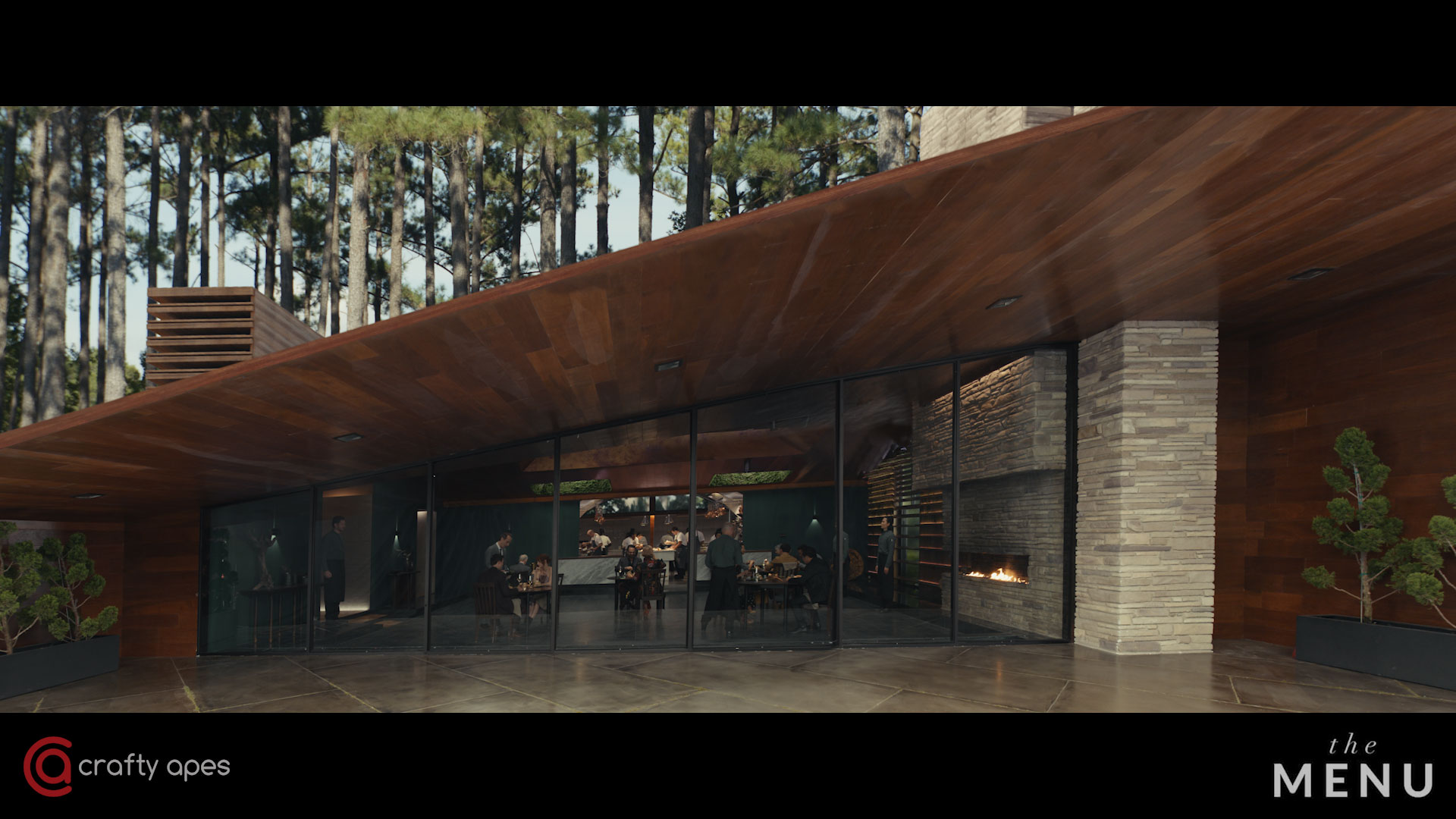
What were his expectations and approach about the visual effects?
Marc Smith // Mark’s expectations were photoreal VFX so that the audience were never asking « is that real or not. » The idea was the VFX would be more supportive of the story, and not be the focal point, so making sure the audience were never snapped out of the experience with anything that caught their eye as to being wrong or looking odd. I think we achieved that with great success for The Menu.
Tanner Bartlett // A common thread in our conversations with Mark that I remember was subtlety and beauty. Everything needed to fit into the sort of cheeky, macabre feel of the movie while also pairing with the decadent culinary elements and plating.
How did you organize the work with your VFX Producer and amongst the Crafty Apes offices?
Marc Smith // Our Producer, Wes Dorough, and coordinator, Tiffany Herzog, along with myself and Tanner Bartlett looked at all the shots and built the team based on the demands of the shots we had. Some were more CG based and others more 2D. The work was completed by the Crafty team mainly comprised of the Atlanta team, with a few specialized people in other offices such as Andrew Furlong, the FX Supervisor.
Tanner Bartlett // Wes and Tiffany really crushed keeping us organized. With so many shots filmed on one set needing VFX to establish the time-of-day out the window, it would have been easy to get lost in which background goes where, but they kept us on the right path all the way through.
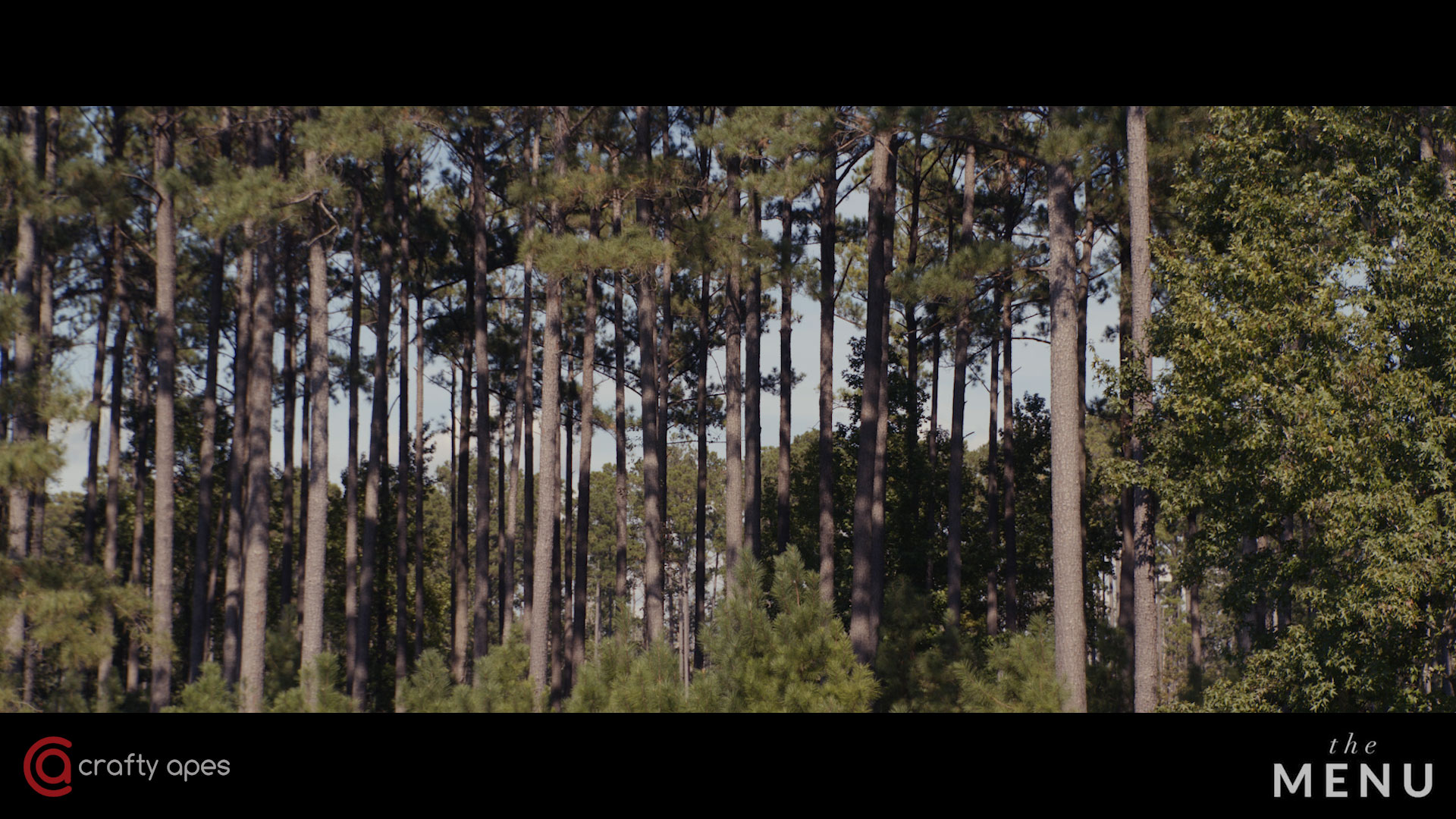
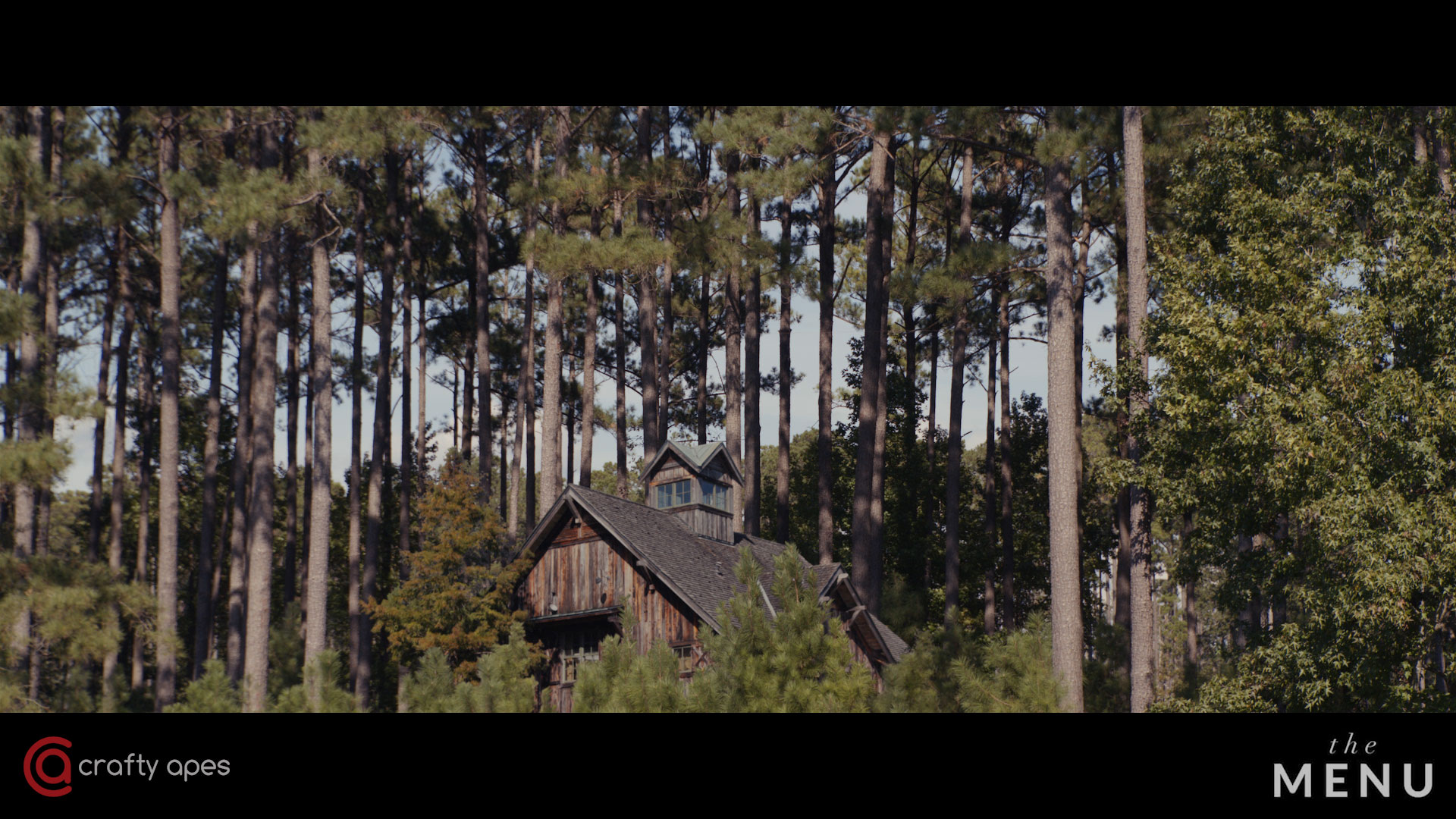
Where were the exterior sequences filmed?
Marc Smith // The whole shoot stage and locations were completed in Savannah, Georgia. We had the expertise of our on-set supervisor, Adam Wagner, throughout the shoot which was invaluable for the information we had at our disposal for the VFX work.
Can you elaborate about the environment work and especially the restaurant?
Marc Smith // The restaurant environment was a 2 stage thing. For the exterior shots of the gardens, etc., we added CG restaurant extensions and built up from the front opening door and through the trees for the roofs, chimneys, etc. based on the blue prints of the restaurant interior so continuity matched.
For the interior, we were tasked with hundreds of BG bluescreen replacements and used array footage we had taken from the exterior location shoot for different times of day that were stitched and then comped into the window shots, making sure we matched the time of day as the story progressed from early to late evening with changing sunsets and sky colors.
Tanner Bartlett // We did a few CG set extensions to establish the exterior of the restaurant as the guests are coming in through the garden, as well as a full CG exterior wide of the restaurant from out on the water, and another, closer shot we stitched together from two separate wide angle plates with a bit of a CG set extension to round it out. Another great environment shot we did was the approach shot of the boat reaching the island. Originally attached to the coast line, we separated a portion of it to make it seem even more of a remote location, from which there is no escape!
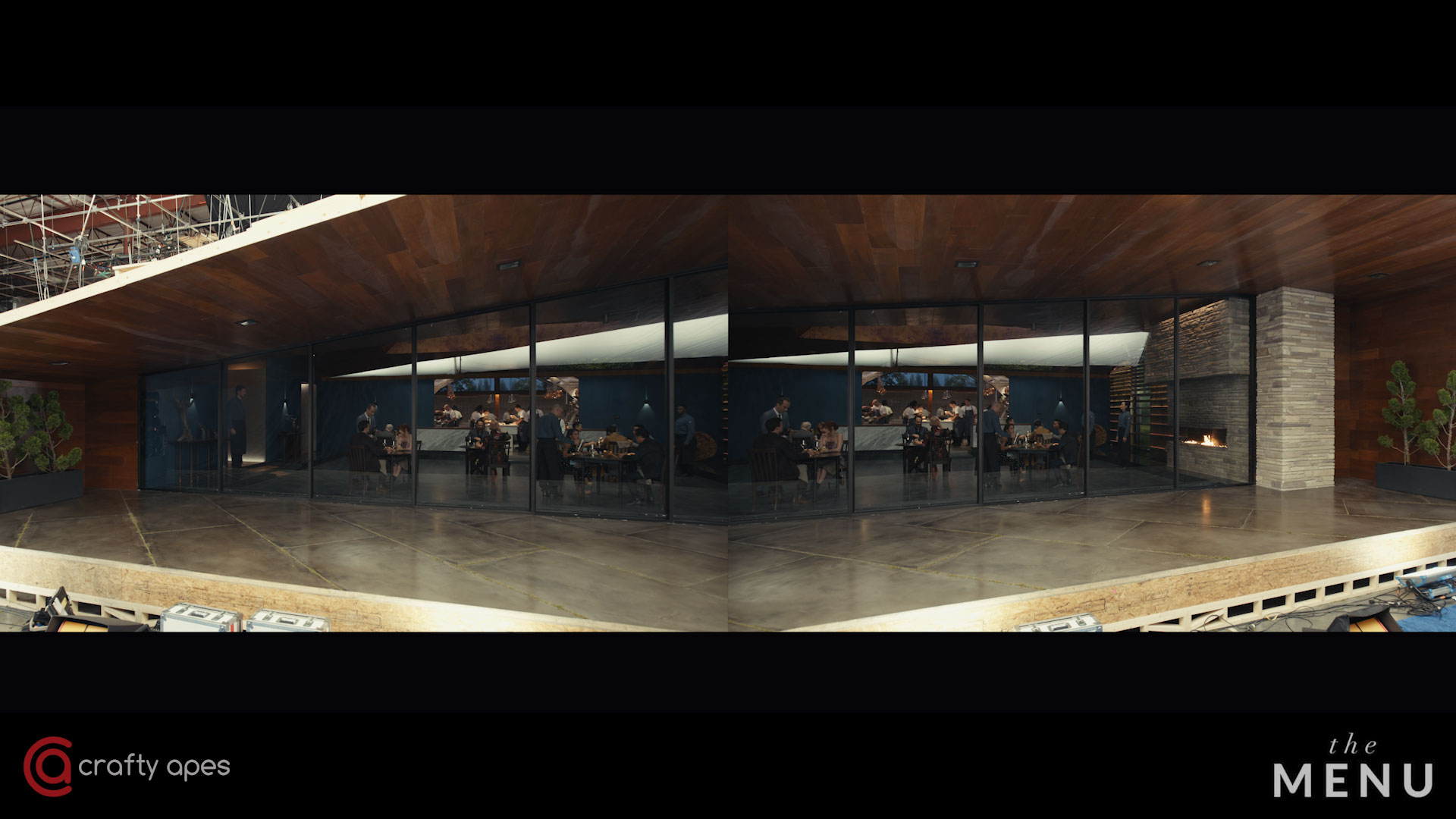
What kind of references did you receive to create the restaurant and the island?
Marc Smith // Again, we were very fortunate to have Adam Wagner on set for this. We always do the whole gamut of references to make sure we are covered, including HDRI, bracketed tiles, slate specific reference photos, texture sessions and light studies and for this specific show and the requirements array footage and element plates over the course of the day, along with the art department sketches and reference of the restaurant layout we were able to cover all the required work.
Tanner Bartlett // Like Marc said, our on-set supervisor Adam took reference photos of just about everything we would possibly need. When you have resources like that combined with artwork and blueprints, everything we need to do to recreate these areas in post is that much easier.
The restaurant has an impressive view of the ocean. Did you use LED techniques?
Marc Smith // No, we did not use LED walls for this, it was all based on the arrays that were shot over the course of a day to collect the unique sky colors and moving ocean and cloud formations. Mark then gave us ranges of what colors and feel he liked for each section of the evening and we pulled TB’s of array plates to stitch and comp in, Tanner will tell you more about that I’m sure.
Tanner Bartlett // All of our sequences looking out the interior window of the restaurant, from dawn to dusk, were good old bluescreens. We used plates Adam shot and stitched them together for each time of day to create a big, panoramic view of the ocean at daytime, sunset, deep sunset, and dusk. We put in a lot of effort on our end to make sure the right portion of the sky was showing from shot to shot as the camera angles changed.
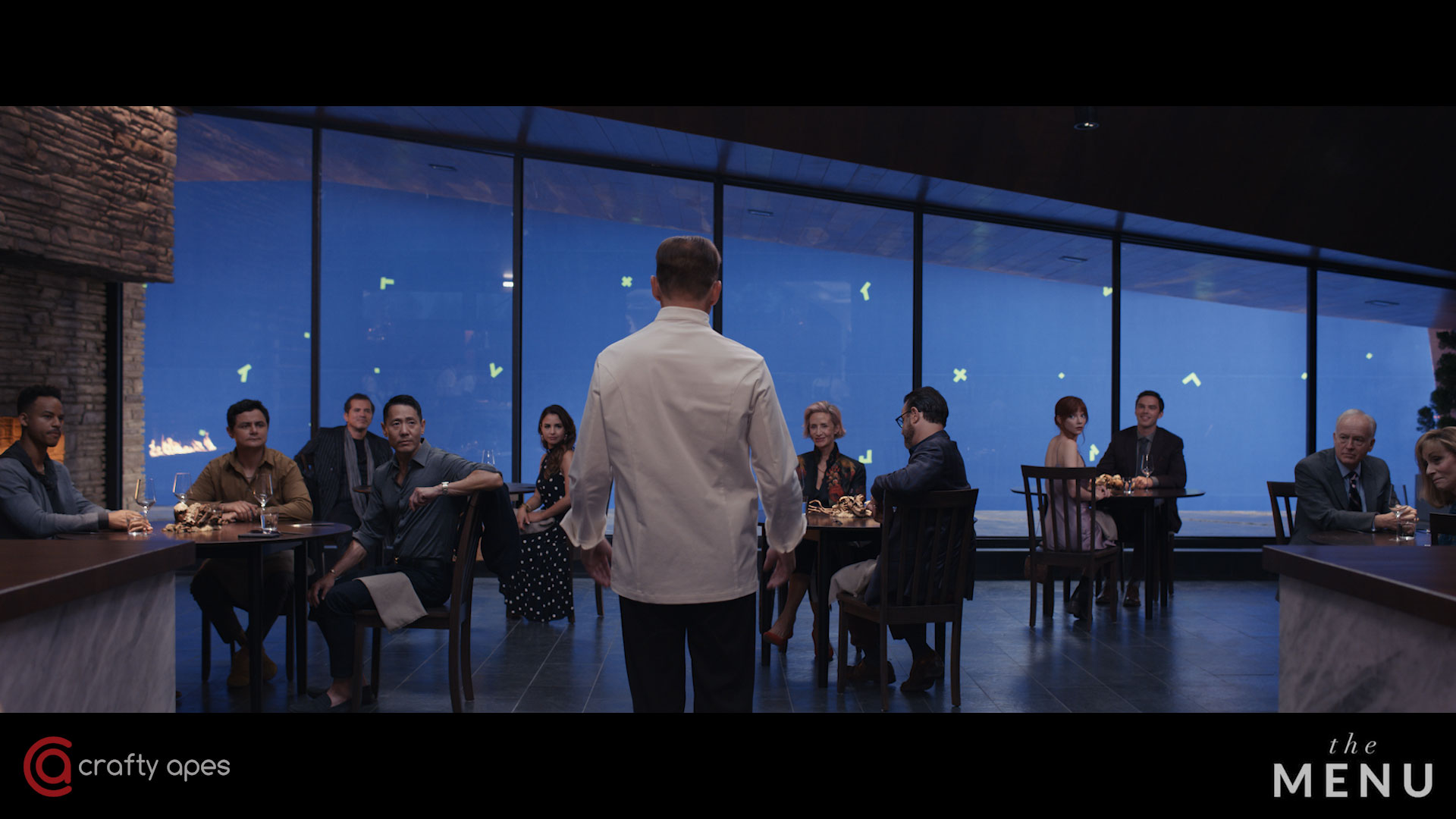
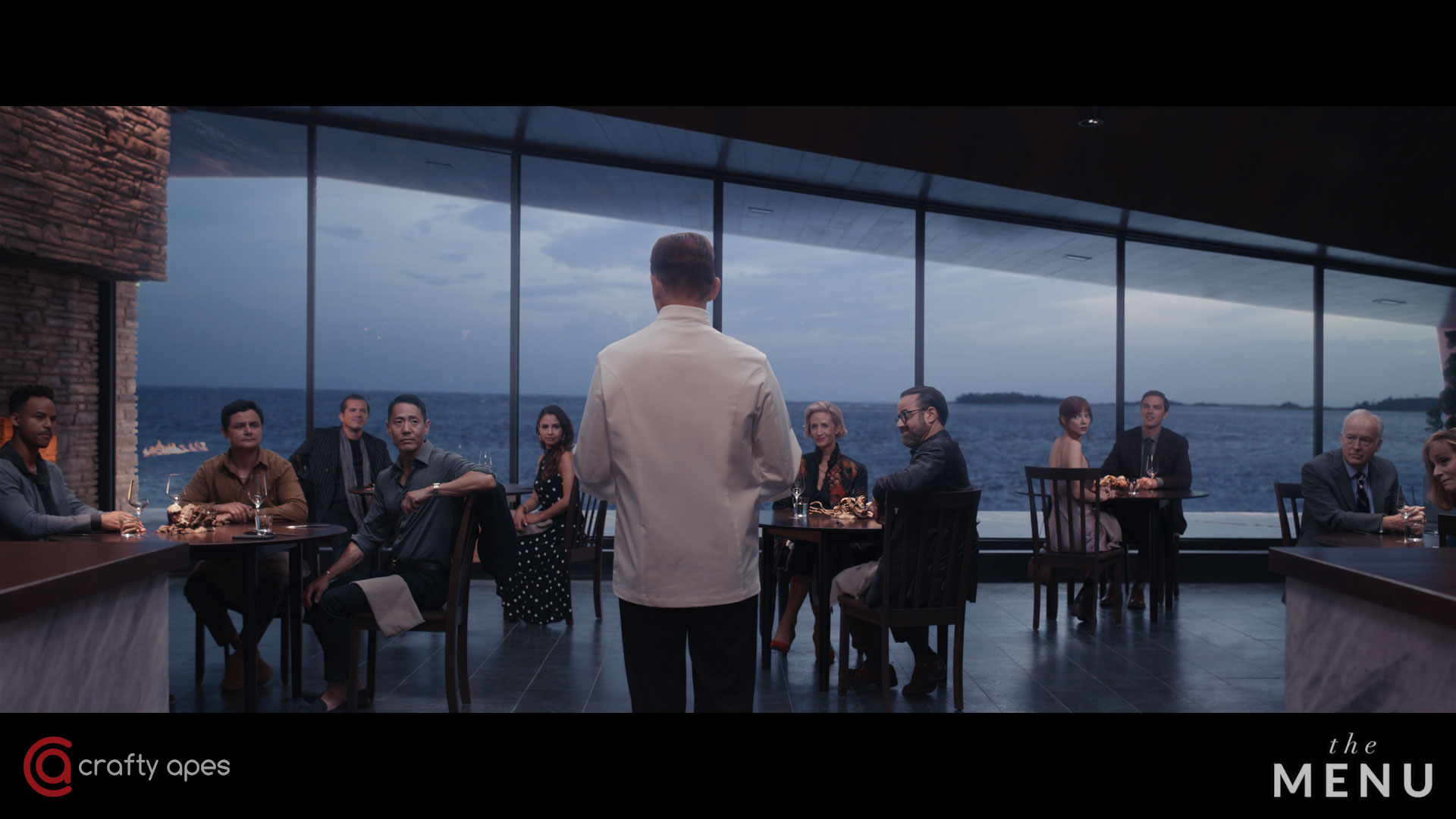
What are the main challenges with the LED walls?
Marc Smith // I have previously used LED walls on other shows and the main issue for me is color. Whatever you put on those screens, the color is so dependent on many factors such as the screens themselves, the brightness, and the resolution of the image and screens. Then you’re seeing a screen through the camera body and lens, adding more issues, so you really need to calibrate those screens based off looking through the shooting camera and have davinci artists or the like color correcting on the fly.
Tanner Bartlett // I don’t have experience with LED stages on this specific project, but you’re quite married to what you shoot on the day using a stage instead of a blue/green screen. If you’ve done the prep in preproduction and have nailed the look, then there’s a huge benefit of some free integration with the FG and BG and you can shoot some truly amazing stuff. You just may not have quite as much wiggle room down the line in post production for big changes. And when you do want to make those changes… that’s a lot of roto!
How did you create the variety of times of day and lighting conditions?
Marc Smith // The arrays took care of that. Again, shooting high res 8k footage and leaving them filming continuously for half hour then waiting for the skies to change and do the same again. We were able to capture all the light changes, cloud formations and ocean highlights to give the perfect photo real BG.
Tanner Bartlett // Adam shot great 3 camera arrays for each time of day, after a bit of stitching, cleanup, and color correction to Mark’s liking – they were ready to roll.
Can you elaborate about the creation and art direction of the FX fire and smoke?
Marc Smith // The FX work was integral to the end sequence of chef. We have Andrew Furlong, our FX supervisor, and Derald Hunt, our CG supervisor, to thank for this. We pulled reference of coal burning and fire ref from on set ref plates and Mark had a very specific idea for this too with the fire burning blue from the oil that was the flammable liquid used. The smoke, fire and sparks, etc. were all FX simulations and again, thanks to Andrew and his expertise, we used the ref we had to match the look we wanted. We didn’t want to cover the plate with black billowing smoke. We still needed to see the action and tell the story, so it was a fine line with transparency.
Tanner Bartlett // This was one area where the “beauty and subtlety” direction really reared its head. When you think of a building going up in a smokey, fiery blaze you can go really heavy with the destruction, but Mark really wanted to keep it as elegant and beautiful as possible while still posing a massive threat and being realistic. It’s Chef’s big finale, he’s meticulously planned every pile of crushed graham cracker and every swirl of chocolate on the “plate” that is the restaurant floor, and our work had to reflect that obsessive preparation. I think our FX team and CG team, led by Andrew and Derald, really nailed the look.
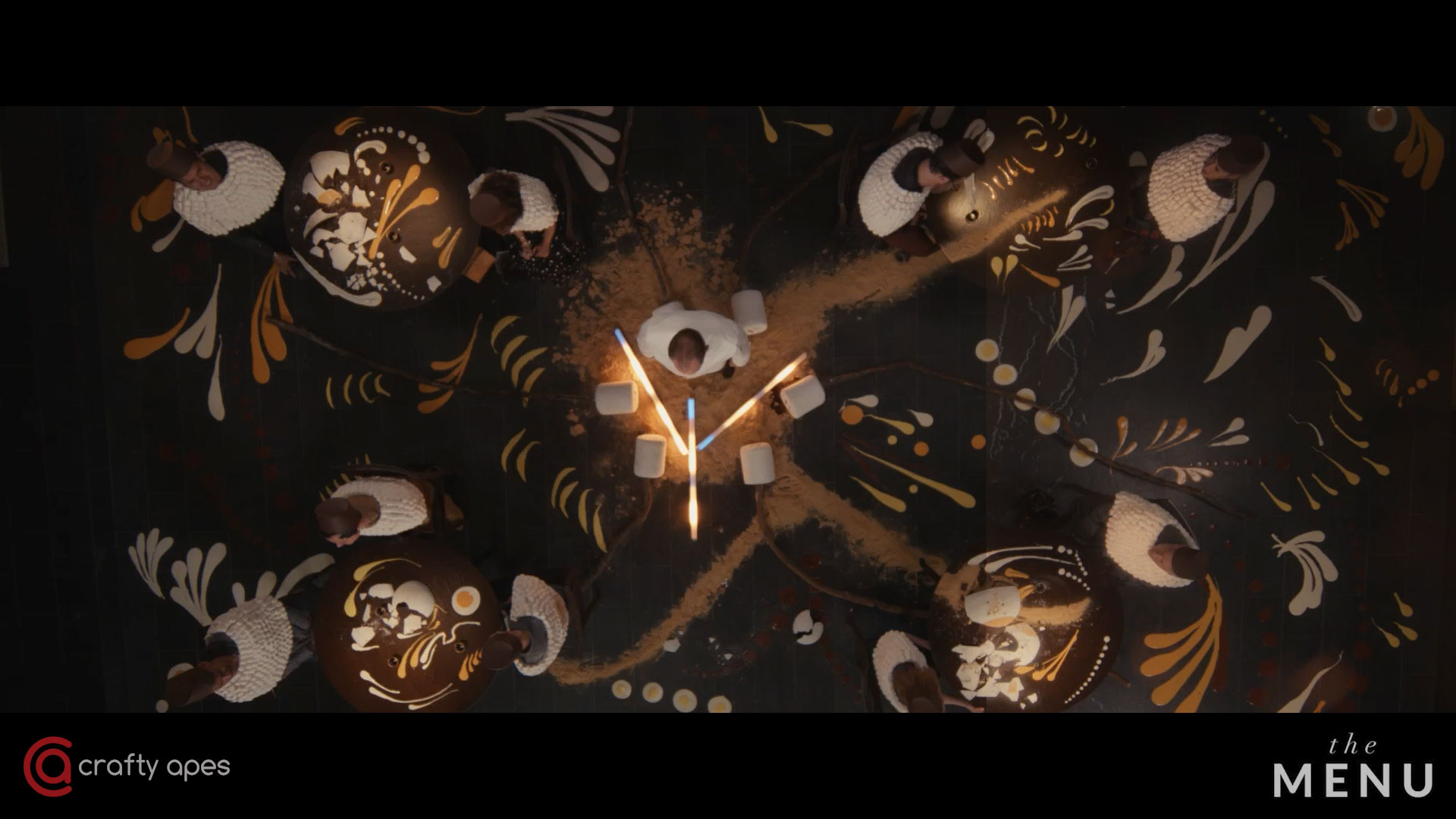
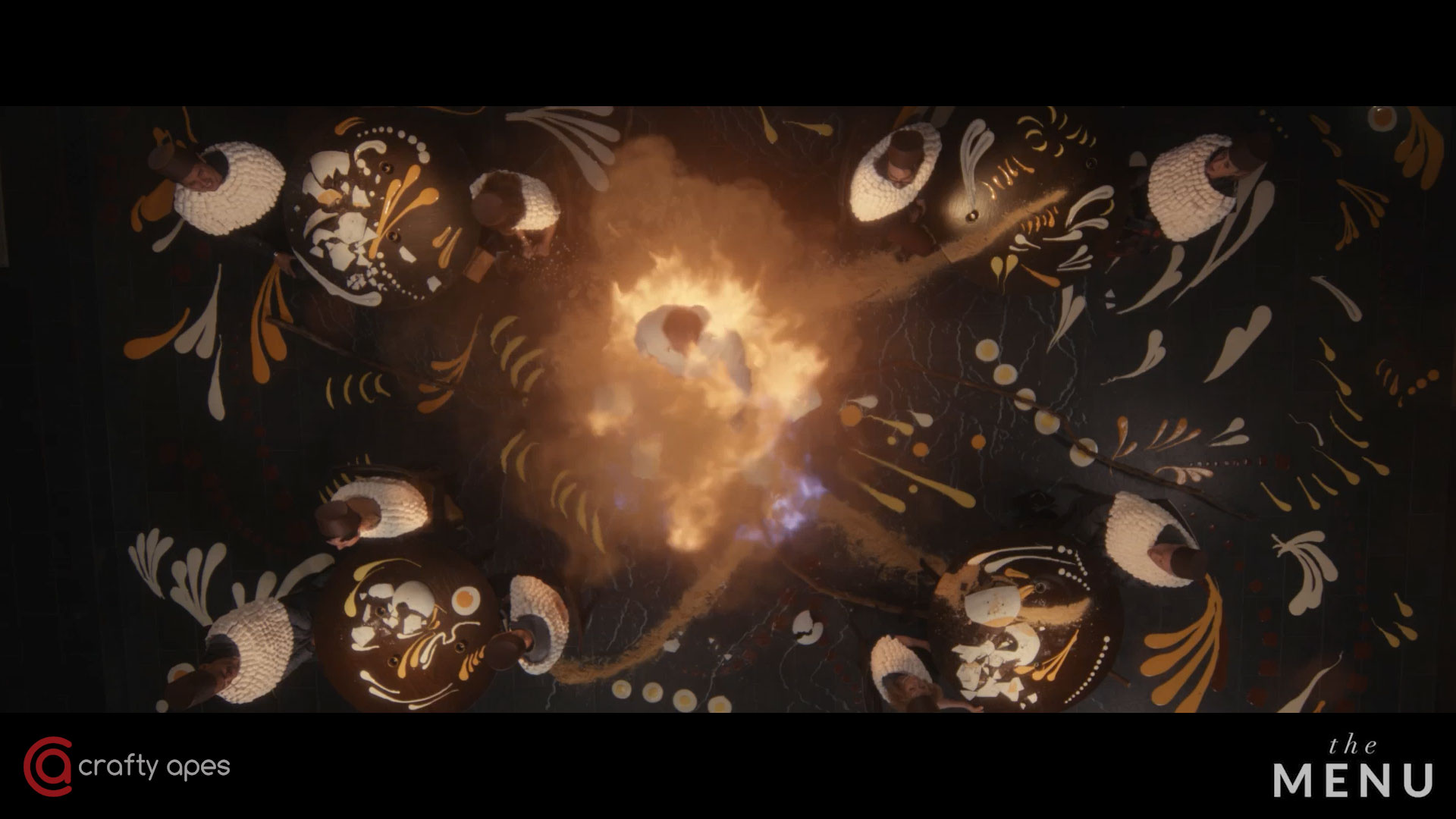
How did you enhance the gore aspect?
Marc Smith // The gore was more additive. Mark didn’t want it to be too intense, but more on the subtle and disturbing side that played so well with the story. We added blood splatter to many shots, along with enhancements of practical effects. We added FX blood to the finger chopping shot, along with 2D blood to many others, and added bruising and slashes to Margot’s arm. Again, Mark wanted this to be dark and not be comical with blood squirting like a hose, so his direction was extremely important to how we approached and achieved the gore enhancements.
Tanner Bartlett // Another area where subtlety was key. The gore effects here really served the story more than being an attraction themselves. Gore too heavy here and there could have easily stolen the moment and we were trying to avoid that as best we could. Though I did hear someone say “ew!” out loud in the theater after one of our shots – so I guess it’s alright if it steals it a little.
Did you want to reveal to us any other invisible effects?
Marc Smith // There are several shots I think we are most proud of. For me, it’s the coal drop – this was a 100% Frankenstein shot with plates, image tiles and FX animation all wrapped into one. We had no plate for this but Mark wanted this shot so we built the plate from multiple sources. The coal, fire and smoke embers are all CG. Tanner also comped a shot where he changed the plate and what the actress was saying to match new dialogue, so he manipulated her mouth to make the words of the new audio VERY impressive as I’m guessing you can’t tell which shot that was. So many shots were very challenging and took some expertise to nail it but the team we had did it time and time again.
Tanner Bartlett // Like Marc mentioned, the shot of Chef dropping the coal to the ground as the camera follows was built entirely from scratch, projecting different elements of the scene onto cards inside of Nuke in 3D space. I used parts of plates from another shot and photos Adam had taken on set to build our new plate. We created a camera move Mark liked, then CG and FX provided us with the coal and FX smoke, sparks, and fire to round the shot out. It’s a very quick shot in the cut, but those twenty frames had a lot of thought and work put into them. The line change was another effect you wouldn’t even think to look for. It required freezing the actors neck and jaw in Nuke and replacing it with a newly animated neck and jaw to match the movement of the new mouth element saying the new line. Another challenge, but a fun shot to do! All of the exterior set extensions of the restaurant play really well, the blood enhancements on Margot’s arms as she fights Elsa – there are so many invisible effects here I could go on and on.
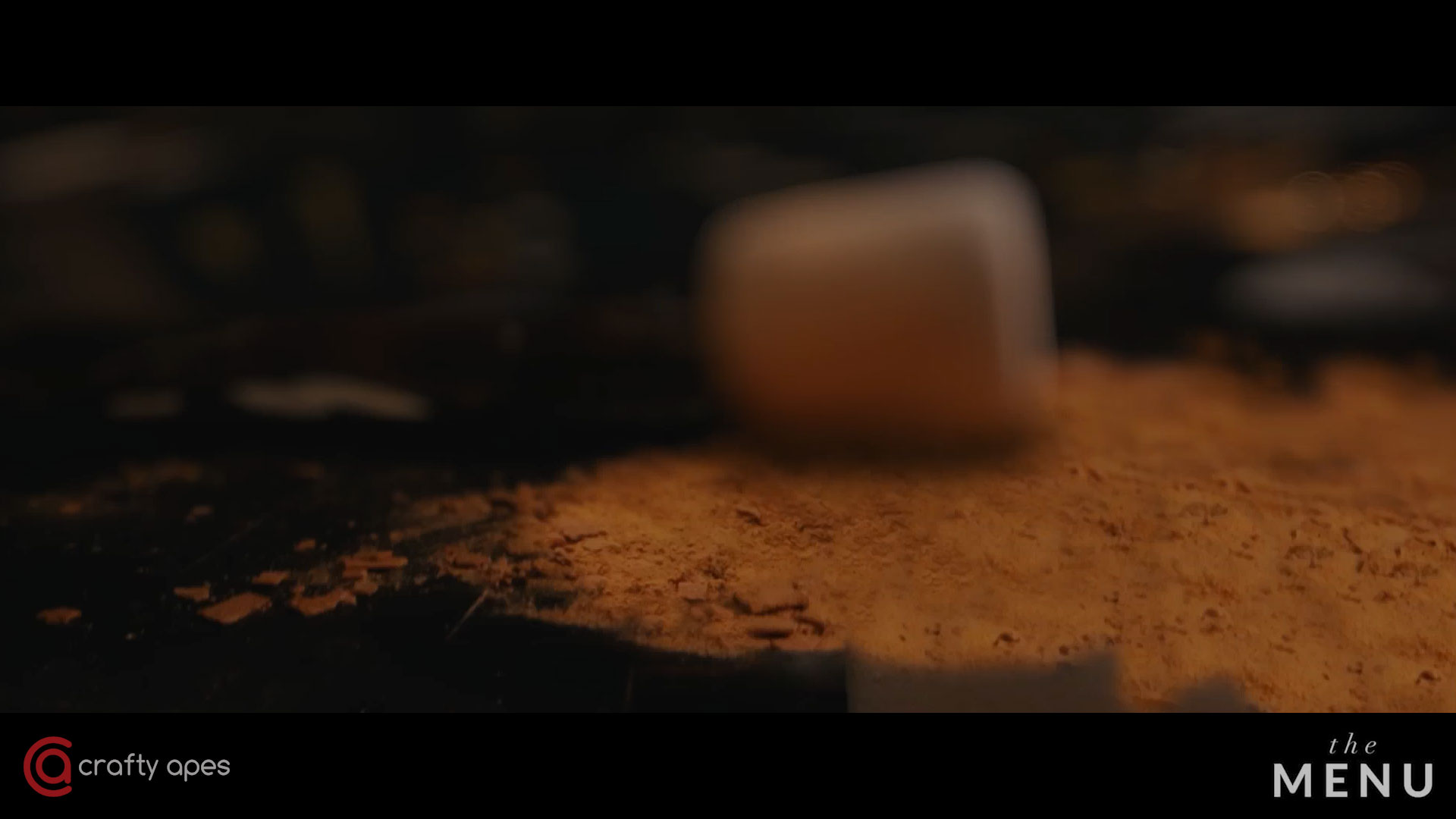
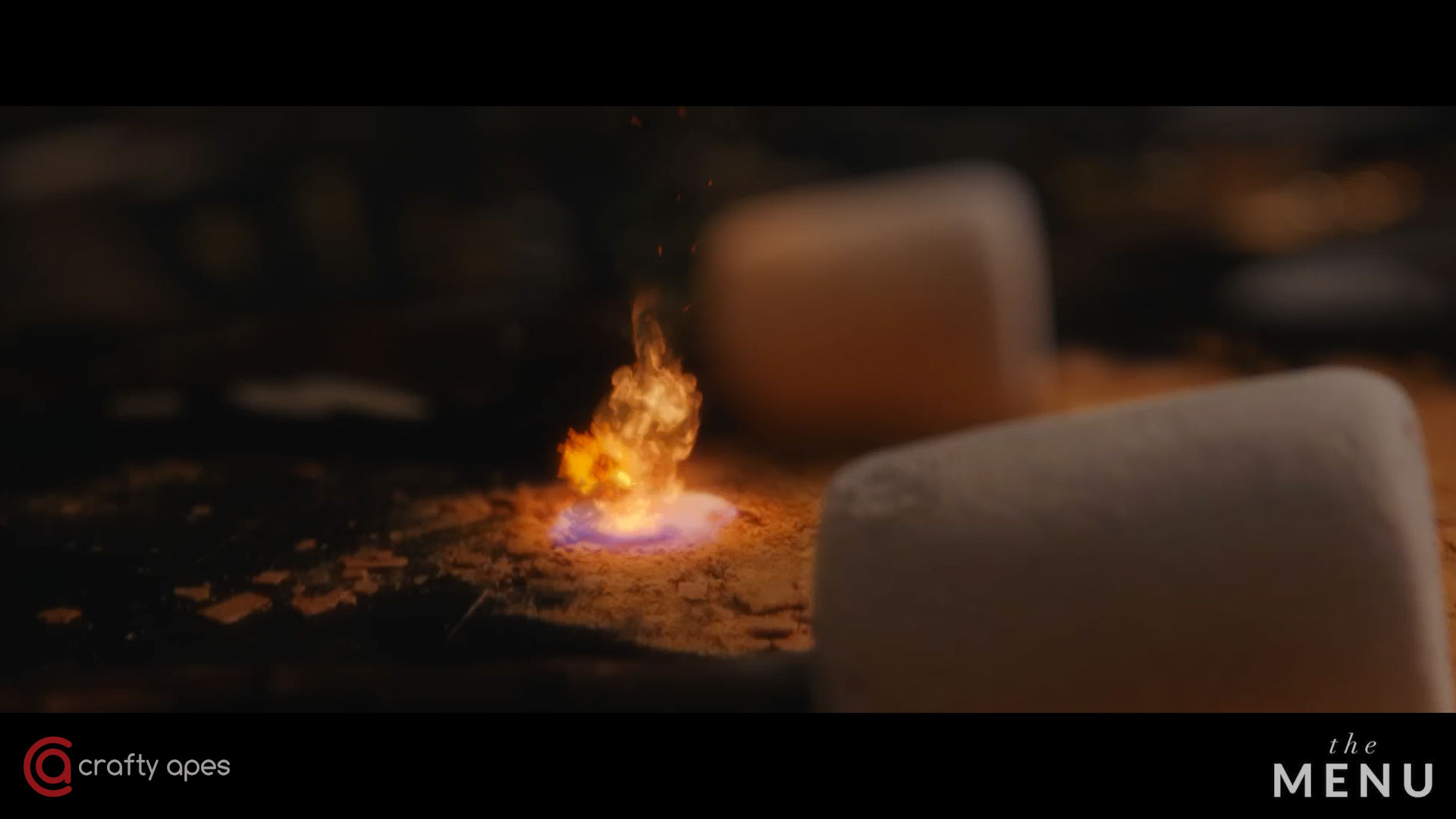
Which shot or sequence was the most challenging?
Marc Smith // I think the end sequence was the biggest challenge and making the fire work with the plate, as we had practical interactive lighting that we needed to cover for Chef’s demise, but obviously no fire. Getting all the light and CG to match convincingly while also adding in the unique blue fire characteristics for shots that did have practical fire, so there was no distinction between the real and the CG fire. Thanks to Derald Hunt and Andrew Furlong, we were able to get all this covered and completed.
Tanner Bartlett // From sheer quantity, the interior blue screen sequences out the restaurant window were a rather large undertaking. Painting out those pesky tracking markers in fine-detail hair and making sure every background lined up in continuity as they cut back and forth from each other took up a big chunk of our time spent on this show. We spent a couple days in the office theater reviewing those shots just watching how they cut together. Those sequences make up such a large portion of the show and our compositing team really buckled down and dominated for us.
Is there something specific that gives you some really short nights?
Tanner Bartlett // Again, just the quantity and quality of shots our teams were churning out daily was both impressive and required a lot of hard work. We wanted to be sure that those windows wouldn’t break the illusion and take the audience out of the movie for a second.
What is your favorite shot or sequence?
Marc Smith // My favourite shot would be the day for night we did. We had a plate where it was shot daytime exterior on the water and we had to change this to an evening shot and fully replace the restaurant exterior with CG. I think this was a big shot that just worked perfectly in a very short space of time.
Tanner Bartlett // Every shot in the finale sequence was just a blast to get to work on, but for me the absolute favorite shot was probably the birds-eye view of Chef going up in flames. I really enjoy doing destruction work and working with FX and this shot was all of that wrapped up in this oddly beautiful and horrible and funny (?!) way to go out for Chef. A close second is the exterior wide of the massive column of smoke and flame after the whole building has gone up.
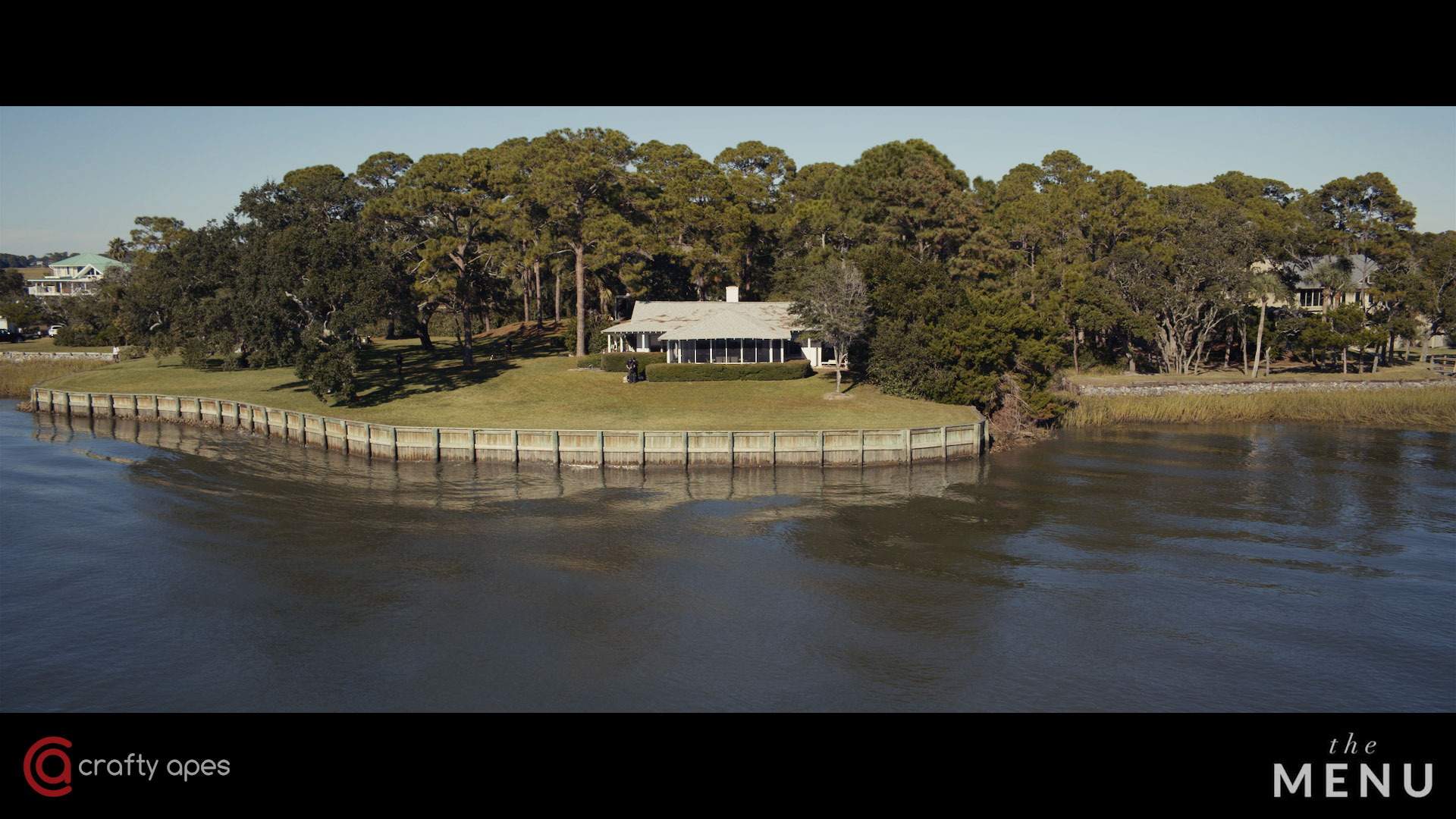
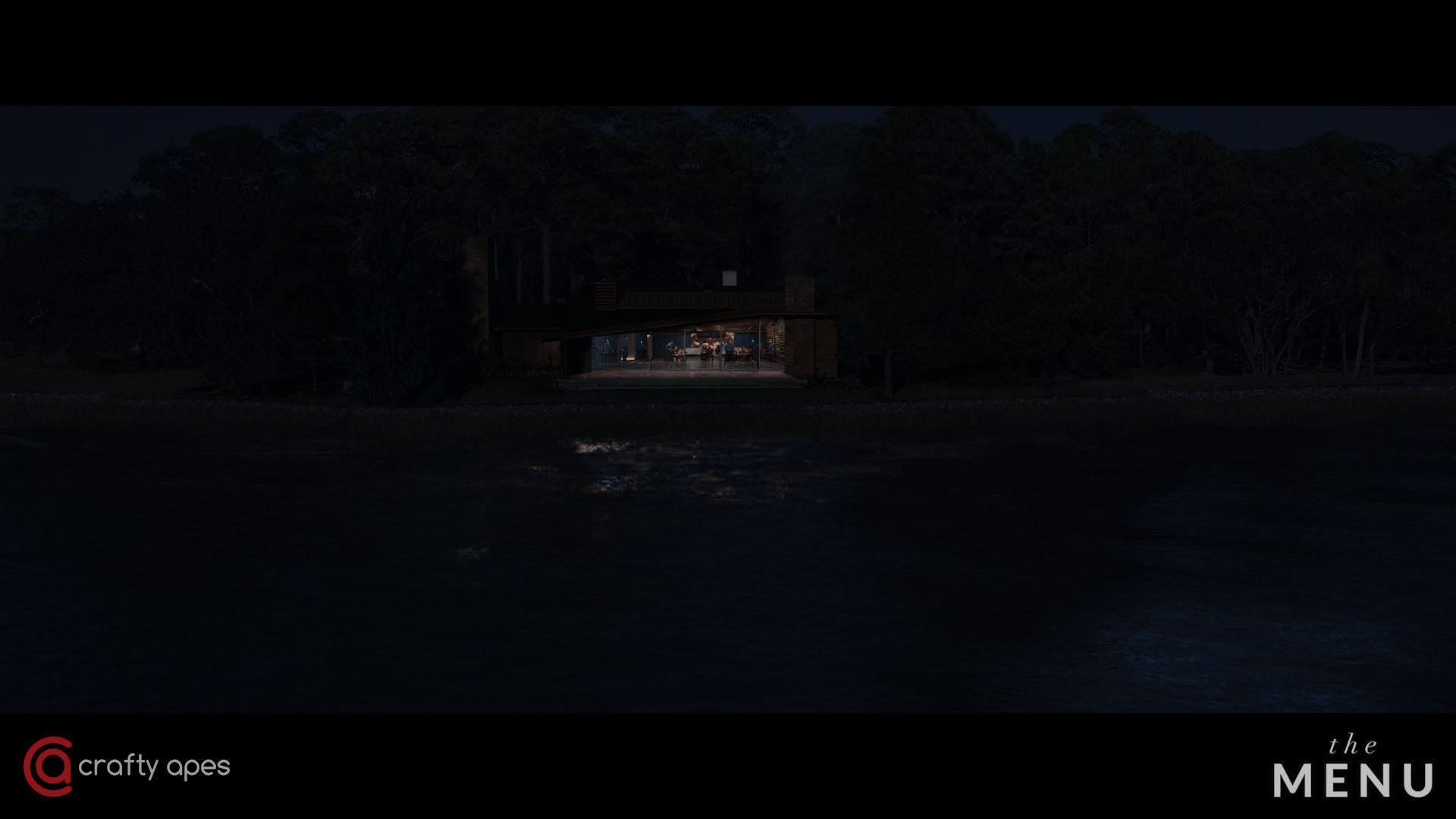
What is your best memory on this show?
Marc Smith // My best memory is going to the SCAD film festival and finally getting to see the movie in all its glory and seeing the reactions from the other attendees and all the wonderful feedback the show has received. I think this is truly a unique movie and is why the feedback has been so positive.
Tanner Bartlett // I really enjoyed those days Marc, Tiffany, Wes, and I spent in the office reviewing the restaurant window sequences. After so much time working remotely, which I absolutely love, it’s nice to get together with your team in person and collaborate face to face. And like Marc said, going to the SCAD Film Festival and seeing the movie for the first time with an audience, hearing everyone’s reactions, and seeing it all in continuity (and with sound) was a really fun experience. It was also my first Compositing Supervisor role on a feature, and it’s really fun for that to be on a movie that I genuinely love watching.
How long have you worked on this show?
Marc Smith // All in all, I think I personally worked on the show for 10 months. I believe I’d have to check the email dates from start to finish ha ha.
Tanner Bartlett // I want to say somewhere in the range of seven months from Kick-Off to Final for me.
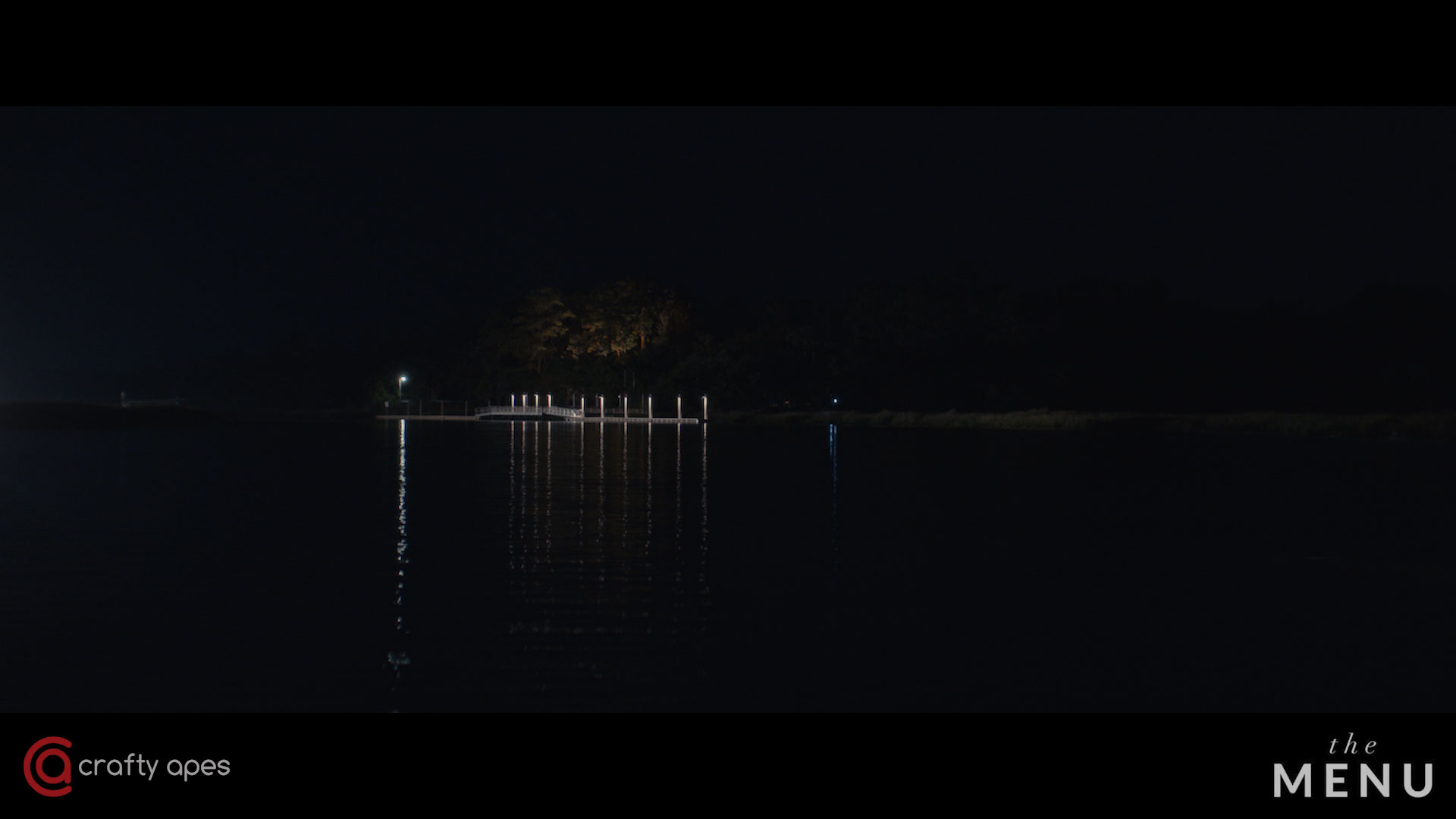
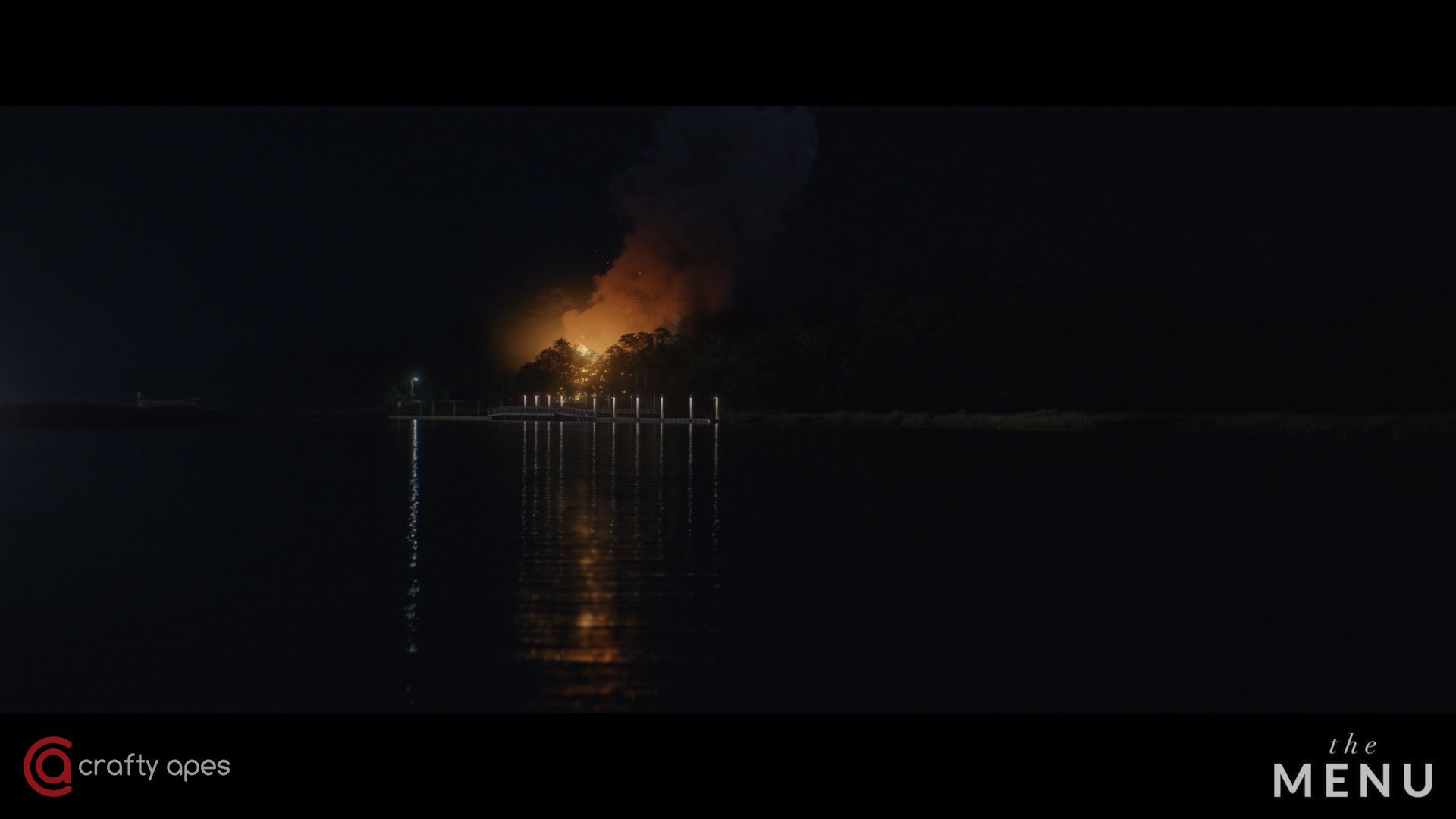
What’s the VFX shots count?
Marc Smith // I believe the VFX shot count ended up in the 350 range.
Tanner Bartlett // I think Marc is right, around 350 is the number I remember.
What was the size of your team?
Marc Smith // The team was fairly small, but that meant we had better quality control and tried to keep artists in the same time of day for the BG comps so we could keep the shots consistent. All in all with production and artists, we came in around the 40 person mark.
Tanner Bartlett // Our team was relatively small, and I think that kept the work really tight overall. 40 seems accurate.
What is your next project?
Marc Smith // My next project to screen will be The Out-Laws on Netflix, once it airs, and I’m currently working on an MGM / Amazon feature as well as starting stages for a big Creature Feature. Not sure I can tell you the titles just yet though.
Tanner Bartlett // Marc and I have become somewhat joined at the hip it seems. A Dream Team, perhaps? I’ll be Pippen, Marc can be MJ. The Out-Laws will be our next project to come out on Netflix and I’ll be Comp Sup-ing for him on both the Snoop Dogg comedy and the Creature Feature.
A big thanks for your time.
WANT TO KNOW MORE?
Crafty Apes: Dedicated page about The Menu on Crafty Apes website.
Disney+: You can watch The Menu on Disney+.
© Vincent Frei – The Art of VFX – 2023





